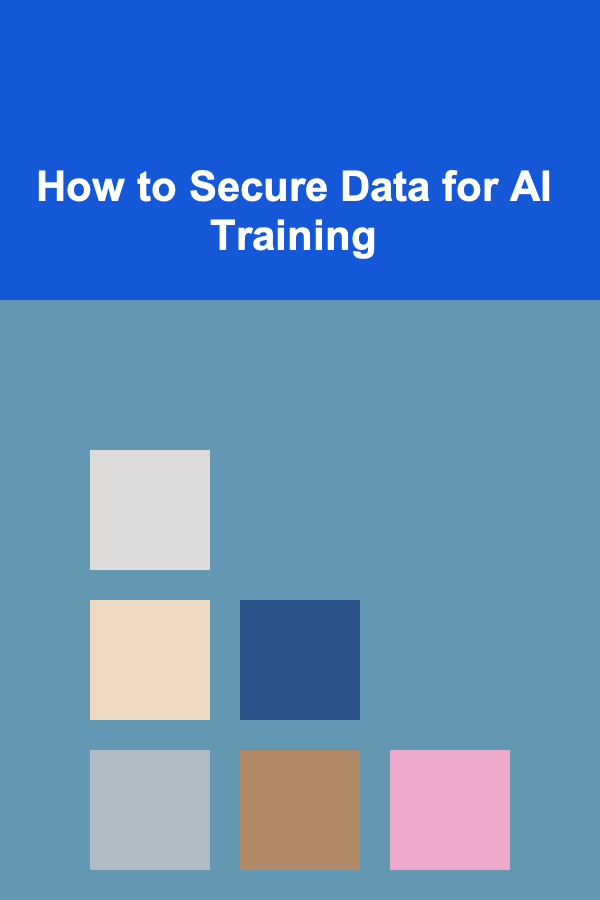
How to Secure Data for AI Training
ebook include PDF & Audio bundle (Micro Guide)
$12.99$8.99
Limited Time Offer! Order within the next:

As artificial intelligence (AI) continues to advance, it is becoming an integral part of numerous industries, from healthcare to finance, marketing to entertainment. One of the cornerstones of AI's capabilities lies in the vast amounts of data used for training machine learning models. However, the more data AI systems consume, the greater the risk of data breaches, misuse, and ethical dilemmas surrounding privacy and security. Thus, securing data for AI training has become a crucial aspect of AI development, requiring careful planning and consideration of various strategies.
In this article, we will explore the importance of securing data for AI training, the potential threats to data security, and the methods that can be employed to safeguard sensitive data. We will also examine how organizations can balance data protection with the need for robust, high-quality AI models and what steps can be taken to minimize the risk of data leaks or cyberattacks.
Why Securing Data for AI Training Matters
AI systems rely on large datasets to learn patterns, make predictions, and generate outcomes. These datasets often contain sensitive, personal, and confidential information that, if compromised, could lead to severe consequences. For example, imagine an AI trained on medical data being exposed to a breach, putting millions of patients' health records at risk.
Beyond the obvious risks of privacy violations, compromised data can lead to other significant issues, such as:
- Bias in AI Models: Unsecured data may be tampered with or altered, leading to biased AI models that can make unfair or harmful predictions. This could result in discriminatory outcomes, especially in sensitive areas like hiring, loan approvals, and law enforcement.
- Loss of Trust: If a company suffers a data breach, it can lose the trust of its users, clients, and partners. In industries like healthcare, where trust is paramount, a breach can have long-lasting repercussions on reputation and credibility.
- Legal Ramifications: Data security breaches often violate regulatory standards such as GDPR (General Data Protection Regulation) or HIPAA (Health Insurance Portability and Accountability Act). Non-compliance with these laws can lead to heavy fines and legal actions.
- Cybersecurity Threats: Data leaks can expose vulnerabilities that cybercriminals can exploit, leading to further attacks on AI systems, servers, or other digital infrastructure.
Thus, ensuring data security for AI training isn't just about preventing unauthorized access to data; it is also about protecting the integrity of AI models, maintaining ethical standards, and adhering to legal requirements.
Types of Data Security Risks in AI Training
Before diving into strategies to secure data, it is essential to understand the types of risks associated with AI training datasets. The major data security risks include:
1. Unauthorized Access
Unauthorized access refers to situations where individuals or entities gain access to datasets they are not permitted to view. This can occur through cyberattacks, such as hacking or phishing, where malicious actors steal or manipulate data. For AI models, unauthorized access can lead to leakage of sensitive information or, worse, the manipulation of training data, which could affect the model's predictions.
2. Data Poisoning
Data poisoning is an attack where adversaries deliberately introduce malicious data into the training dataset to corrupt the learning process. The intention behind data poisoning is to influence the behavior of the AI system in a way that benefits the attacker. This type of attack can cause AI systems to make incorrect predictions or even act maliciously.
3. Model Inversion Attacks
Model inversion attacks occur when attackers reverse-engineer a trained model to extract sensitive information from the training data. These attacks can reveal confidential data points used to train the model, such as personal information from medical records or financial data.
4. Data Breaches
A data breach refers to unauthorized access to datasets, leading to data leakage. This is often the result of weak access controls, outdated security measures, or lack of proper encryption. A breach could expose not just individual data points but also intellectual property used in AI development, including proprietary algorithms and model parameters.
5. Insider Threats
Not all data security risks come from external sources. Insider threats occur when individuals with authorized access to data misuse that access. This could include data theft, accidental leakage, or intentional manipulation of data. Insiders may include employees, contractors, or other trusted individuals.
Strategies to Secure Data for AI Training
Securing data for AI training involves a combination of technical measures, best practices, and organizational strategies. Here are the primary ways to protect AI training data:
1. Data Encryption
Encryption is one of the most effective ways to protect sensitive data. When data is encrypted, it becomes unreadable to anyone without the correct decryption key. In the context of AI, both data at rest (stored data) and data in transit (data being transmitted) should be encrypted.
- End-to-end encryption ensures that data remains secure while being transferred between different entities or systems.
- Homomorphic encryption allows computations to be performed on encrypted data, ensuring that the AI model can learn from the data without ever exposing it.
2. Differential Privacy
Differential privacy is a technique used to ensure that the data used to train AI models does not reveal private information about individuals. By adding noise to the dataset or to the model's output, differential privacy makes it difficult to infer details about any specific data point, even if an attacker has access to the trained model.
This technique is especially useful when working with sensitive data, such as personal health information or financial data, where maintaining privacy is crucial.
3. Data Anonymization and Pseudonymization
Anonymization and pseudonymization are techniques used to remove or obscure personally identifiable information (PII) from datasets. Anonymization involves completely removing all identifiable information, while pseudonymization substitutes real identifiers with fake ones, making it harder to trace the data back to a specific individual.
Both methods help to reduce the risks associated with data leaks and breaches, ensuring that even if data is exposed, it cannot be traced back to any individual.
4. Access Control and Authentication
Strict access controls are essential for limiting who can access the training data and AI models. Access should be based on the principle of least privilege, ensuring that individuals only have access to the data necessary for their role.
Additionally, authentication methods such as multi-factor authentication (MFA) should be implemented to prevent unauthorized access to sensitive datasets. This ensures that even if an attacker obtains a user's credentials, they cannot gain access without completing additional verification steps.
5. Secure Data Storage
Storing AI training data securely is critical to preventing data breaches. Organizations should use secure storage solutions, such as encrypted cloud storage or on-premise data centers with robust physical and network security.
- Cloud storage providers often offer built-in security features such as encryption, access control, and auditing capabilities. However, it is essential to ensure that the cloud provider meets the necessary regulatory standards (e.g., GDPR, HIPAA).
- On-premise storage allows organizations to maintain full control over their data, but it requires investments in security infrastructure and continuous monitoring.
6. Data Minimization
Data minimization is a principle that encourages the collection of only the necessary data for training purposes. By reducing the volume of data collected, organizations can reduce the risk of exposure and simplify compliance with data protection regulations.
In AI, data minimization also involves selecting the right data features, which can help reduce the potential for bias and improve the efficiency of training. By focusing on the most relevant data, organizations can limit the amount of sensitive information involved in the training process.
7. Regular Audits and Monitoring
Organizations should regularly audit their data security practices and monitor access to training datasets. This includes conducting penetration tests, vulnerability assessments, and reviewing access logs for unusual activities. Regular audits can help detect vulnerabilities early and prevent data breaches.
Continuous monitoring helps identify potential threats and allows organizations to respond quickly to security incidents, reducing the impact of any security breaches.
8. Collaborative Data Sharing with Security Measures
In some cases, organizations may need to collaborate with third parties, such as research institutions or other companies, for data sharing. This can be done securely by implementing secure data sharing protocols, such as secure multi-party computation (SMPC) or federated learning.
Federated learning allows AI models to be trained collaboratively across different data sources without sharing the raw data itself. This can help protect data privacy while still benefiting from diverse datasets.
9. Legal and Regulatory Compliance
Organizations must adhere to legal frameworks and data protection regulations when handling AI training data. Regulations such as GDPR, CCPA, and HIPAA outline specific requirements for securing personal data, and failure to comply can result in significant fines and reputational damage.
Moreover, organizations should ensure that their data processing practices are transparent and that users are informed about how their data is being used in AI training. Obtaining proper consent and providing clear privacy policies are essential for legal compliance.
10. Employee Training and Awareness
Finally, it is crucial to train employees on data security best practices and raise awareness about the potential risks associated with AI training data. Employees should be educated on how to handle sensitive data, the importance of encryption and secure access controls, and how to recognize potential threats such as phishing attacks.
An organization's security culture plays a key role in preventing data breaches and ensuring that all individuals involved in AI development understand the risks and responsibilities associated with data security.
Conclusion
Securing data for AI training is a complex and ongoing challenge that requires a multifaceted approach. As AI continues to evolve and permeate every sector, it is critical to implement robust data security measures that protect sensitive information while ensuring the integrity of AI models. By adopting encryption, differential privacy, access controls, secure storage solutions, and regular audits, organizations can safeguard data and minimize the risks of breaches or misuse.
Additionally, compliance with legal and regulatory frameworks, as well as educating employees about data security best practices, is essential for maintaining a strong security posture. With the right measures in place, organizations can confidently use AI to drive innovation while ensuring that privacy, ethics, and security remain a top priority.

How to Clean Your Home Using Only Eco-Friendly Products
Read More
How to Combine Photography with Travel for a Fun and Commercially Viable Side Hustle
Read More
How to Design Conference Materials: A Checklist for Professional and Informative Content
Read More
How to Make Money Online as a Craft Seller: 10 Actionable Ideas
Read More
How to Render Fat for Cooking
Read More
How to Design Eco-Friendly Product Packaging
Read MoreOther Products

How to Clean Your Home Using Only Eco-Friendly Products
Read More
How to Combine Photography with Travel for a Fun and Commercially Viable Side Hustle
Read More
How to Design Conference Materials: A Checklist for Professional and Informative Content
Read More
How to Make Money Online as a Craft Seller: 10 Actionable Ideas
Read More
How to Render Fat for Cooking
Read More